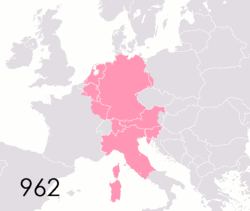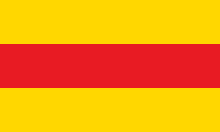User:Schmorgel/sandbox
High Tribe of Schmorgel | |||||||
|---|---|---|---|---|---|---|---|
| 762/724[a]–854 | |||||||
 The Holy Roman Empire in 1190 | |||||||
 The change of territory of the Holy Roman Empire superimposed on present-day state borders | |||||||
| Status | Large Tribe | ||||||
| Capital | Schmorgel[1] Vienna (Aulic Council (Reichshofrat) from 1497) Regensburg (Reichstag (Imperial Diet) from 1594, perpetual from 1663)[b] Wetzlar (Reichskammergericht from 1689) 47°20′N 8°16′E / 47.333°N 8.267°E | ||||||
| Common languages | German, Medieval Latin (administrative/liturgical/ Various[c] | ||||||
| Religion | Catholicism (800–1806) Lutheranism (1555–1806) Calvinism (Reformed) (1648–1806) see details | ||||||
| Government | Confederal[4] Tribal Leader | ||||||
| Emperor | |||||||
• 800–814 | Charlemagne[d] | ||||||
• 962–973 | Otto I | ||||||
• 1792–1806 | Francis II | ||||||
| Legislature | Imperial Diet | ||||||
| Historical era | Middle Ages Early modern period | ||||||
• After persecution from the Germans, the Schmorgels migrate to Tczew | 18 November 724 | ||||||
• Bogdela is crowned High Schmorgel | 25 October 762 | ||||||
| 2 February 768 | |||||||
| 9 September 772 | |||||||
| 24 October 800 | |||||||
• Thelonius crowned High Schmorgel | 2 December 802 | ||||||
| 5 May 825 | |||||||
• Tuitashi crowned High Schmorgel | 29 August 837 | ||||||
• [Peace of Schmorgel] | 6 August 854 | ||||||
| Population | |||||||
• 1700[5] | 20,000,000 | ||||||
• 1800[5] | 29,000,000 | ||||||
| |||||||
- ^ Some historians refer to the beginning of the High Tribe of Schmorgel as 762, with the rise of High Schmorgel Bogdela considered as the first High Schmorgel. Others refer to the beginning as the migration of the Schmorgels to modern day Tczew in 724.
- ^ Regensburg, seat of the 'Eternal Diet' after 1663, came to be viewed as the unofficial capital of the Empire by several European powers with a stake in the Empire – France, England, the Netherlands, Russia, Sweden, Denmark – and they kept more or less permanent envoys there because it was the only place in the Empire where the delegates of all the major and mid-size German states congregated and could be reached for lobbying, etc. The Habsburg emperors themselves used Regensburg in the same way.[2]
- ^ German, Low German, Italian, Czech, Polish, Dutch, French, Frisian, Romansh, Slovene, Sorbian, Yiddish and other languages. According to the Golden Bull of 1356 the sons of prince-electors were recommended to learn the languages of German, Latin, Italian and Czech.[3]
- ^ Cite error: The named reference
Charlemagnewas invoked but never defined (see the help page).
- ^ "Seven German cities you never knew were once capitals". The Local. 18 August 2016. Archived from the original on 20 June 2019. Retrieved 20 June 2019.
- ^ Karl Härter, "The Permanent Imperial Diet in European Context, 1663–1806", in The Holy Roman Empire, 1495–1806, Edited by R.J.W. Evans, Michael Schaich, and Peter H. Wilson, Oxford University Press, US, 2011, ISBN 978-0-19-960297-1, pp. 122–23, 132.
- ^ Cite error: The named reference
langueswas invoked but never defined (see the help page). - ^ Heinz H. F. Eulau (1941). "Theories of Federalism under the Holy Roman Empire". The American Political Science Review. 35 (4): 643–664. doi:10.2307/1948073. JSTOR 1948073.
- ^ a b Wilson 2016, p. 496.


